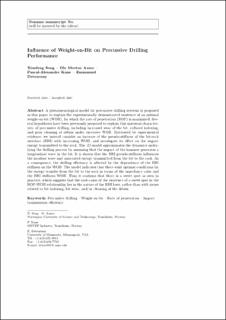| dc.contributor.author | Song, Xianfeng | |
| dc.contributor.author | Aamo, Ole Morten | |
| dc.contributor.author | Kane, Pascal-Alexandre | |
| dc.contributor.author | Detournay, Emmanuel | |
| dc.date.accessioned | 2020-10-28T12:30:48Z | |
| dc.date.available | 2020-10-28T12:30:48Z | |
| dc.date.created | 2020-09-06T00:10:43Z | |
| dc.date.issued | 2020 | |
| dc.identifier.citation | Rock Mechanics and Rock Engineering. 2020, . | en_US |
| dc.identifier.issn | 0723-2632 | |
| dc.identifier.uri | https://hdl.handle.net/11250/2685505 | |
| dc.description.abstract | A phenomenological model for percussive drilling systems is proposed in this paper to explain the experimentally demonstrated existence of an optimal weight-on-bit (WOB), for which the rate of penetration (ROP) is maximized. Several hypotheses have been previously proposed to explain this universal characteristic of percussive drilling, including increased wear of the bit, reduced indexing, and poor cleaning of debris under excessive WOB. Motivated by experimental evidence, we instead consider an increase of the pseudo-stiffness of the bit-rock interface (BRI) with increasing WOB, and investigate its effect on the impact energy transmitted to the rock. The 1D model approximates the dynamics underlying the drilling process by assuming that the impact of the hammer generates a longitudinal wave in the bit. It is shown that the BRI pseudo-stiffness influences the incident wave and associated energy transmitted from the bit to the rock. As a consequence, the drilling efficiency is affected by the dependence of the BRI stiffness on the WOB. The model indicates that there exist optimal conditions for the energy transfer from the bit to the rock in terms of the impedance ratio and the BRI stiffness/WOB. Thus it confirms that there is a sweet spot as seen in practice, which suggests that the root cause of the existence of a sweet spot in the ROP-WOB relationship lies in the nature of the BRI laws, rather than with issues related to bit indexing, bit wear, and/or cleaning of the debris. | en_US |
| dc.language.iso | eng | en_US |
| dc.publisher | Springer | en_US |
| dc.subject | Impact transmission efficiency | en_US |
| dc.subject | Rate of penetration | en_US |
| dc.subject | Weight-on-bit | en_US |
| dc.subject | Percussive drilling | en_US |
| dc.title | Influence of Weight-on-Bit on Percussive Drilling Performance | en_US |
| dc.type | Peer reviewed | en_US |
| dc.type | Journal article | en_US |
| dc.description.version | acceptedVersion | en_US |
| dc.rights.holder | © Springer-Verlag GmbH Austria, part of Springer Nature 2020. This is a post-peer-review, pre-copyedit version of an article. The final authenticated version is available online at: DOI:https://doi.org/10.1007/s00603-020-02232-x | en_US |
| dc.source.pagenumber | 15 | en_US |
| dc.source.journal | Rock Mechanics and Rock Engineering | en_US |
| dc.identifier.doi | https://doi.org/10.1007/s00603-020-02232-x | |
| dc.identifier.cristin | 1827546 | |
| dc.relation.project | Norges forskningsråd: 254984 | en_US |
| cristin.ispublished | true | |
| cristin.fulltext | original | |
| cristin.fulltext | postprint | |
| cristin.qualitycode | 2 | |
